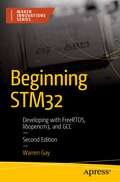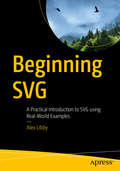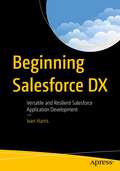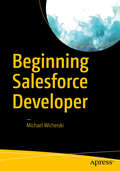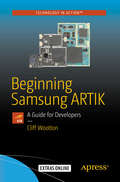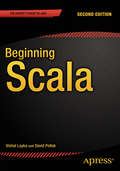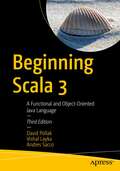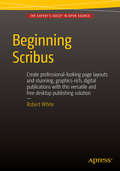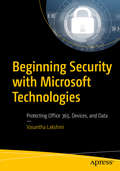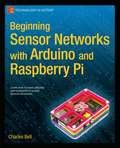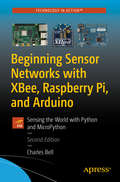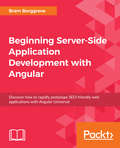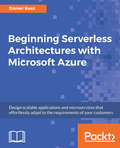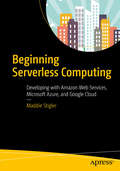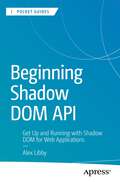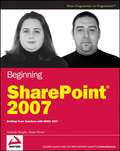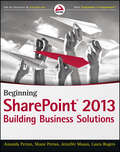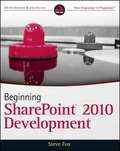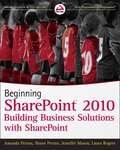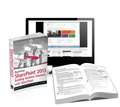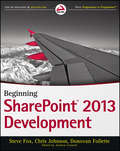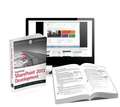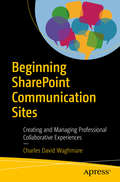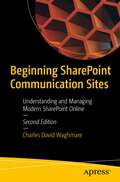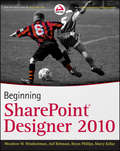- Table View
- List View
Beginning STM32: Developing with FreeRTOS, libopencm3, and GCC (Maker Innovations Series)
by Warren GaySee how using FreeRTOS and libopencm3 instead of the Arduino software environment will help you develop multi-tasking applications that go beyond Arduino norms. This updated version includes expanded coverage of software setup for Windows 10 and 11, additional TM32 hardware capabilities, including clear explanations of "totem pole outputs" versus "open drain outputs," and a new section on project showcasing an interrupt-driven approach for processing USART data.Each chapter contains clear explanations of the STM32 hardware capabilities to help get you started with the device, including GPIO and several other ST Microelectronics peripherals like USB and CAN bus controller. You’ll learn how to download and set up the libopencm3 + FreeRTOS development environment, using GCC. With everything set up, you’ll leverage FreeRTOS to create tasks, queues, and mutexes. You’ll also learn to work with the I2C bus to add GPIO using the PCF8574 chip. And how to create PWM output for RC control using hardware timers.You'll be introduced to new concepts that are necessary to master the STM32, such as how to extend code with GCC overlays using an external Winbond W25Q32 flash chip. Your knowledge is tested at the end of each chapter with exercises. Upon completing this book, you’ll be ready to work with any of the devices in the STM32 family. Beginning STM32, Second Edition provides the professional, student, or hobbyist a way to learn about ARM without costing an arm!What You'll Learn Initialize and use the libopencm3 drivers and handle interruptsUse DMA to drive a SPI based OLED displaying an analog meterRead PWM from an RC control using hardware timersUnderstand STM32 capabilities, including USB controller, RTC, DMA, CAN bus, and more Who This Book Is ForExperienced embedded engineers, students, hobbyists and makers wishing to explore the ARM architecture, going beyond Arduino limits.
Beginning SVG: A Practical Introduction to SVG using Real-World Examples
by Alex LibbyDevelop SVG functionality for use within websites quickly and natively, using basic tools such as HTML and CSS. This book is a project-oriented guide to creating and manipulating scalable vector graphics in the browser for websites or online applications, using little more than a text editor or free software, and the power of JavaScript. You'll use a starting toolset to incorporate into your existing workflow, develop future projects, and reduce any dependency on graphics applications for simple projects. This book is an excellent resource for getting acquainted with creating and manipulating SVG content. We live in an age where speed and simplicity are of the essence. Beginning SVG provides a perfect alternative when creating web-based projects that challenges the norm and encourages you to expand your resources and not resort to what “everyone else uses” (such as Illustrator). You'll discover that there is indeed a different way to achieve the same result. Stop thinking you must always resort to using graphics packages; there is always another way!What You'll LearnCreate powerful, optimized content that can be quickly and easily manipulated within the browserGet up to speed with SVG quickly, with minimal effort and maximum resultsSee how easy it is to apply SVG content and effects, without the need for lots of additional tools.Who This Book Is For Website developers and agile development teams who are keen to learn how to add and manipulate SVG quickly.
Beginning Salesforce DX: Versatile and Resilient Salesforce Application Development
by Ivan HarrisRefer to the practical guidance provided in this book to develop Salesforce custom applications in a more agile, collaborative, and resilient way using Salesforce Developer Experience (DX). You will learn how to use the Salesforce Command Line Interface (CLI) to simplify working with projects, metadata, data and orgs. The CLI integrates with your development tools of choice such as Visual Studio Code, and CI/CD tools to implement DevOps pipelines. Readers will also gain an understanding of the package development model, which improves application quality and maintainability by grouping metadata into highly cohesive, loosely coupled containers. Salesforce DX supports application development throughout the entire development lifecycle where a version control system, rather than a Salesforce org, is the source of truth. It became generally available in late 2017 and has now reached a stage of feature richness and stability that it is becoming more widely adopted. Beginning Salesforce DX provides development teams with practical, how-to examples of using Salesforce DX that go beyond the Salesforce documentation. Commands and their parameters are described, including any gotchas, and the outcome of the commands on a Salesforce org is explained. What You Will Learn • How to setup a Salesforce DX development environment • Understand the key Salesforce DX concepts and the Salesforce CLI • Work with Dev Hubs, projects, orgs, metadata and version control systems • Improve quality with test users and test data • Bootstrap pro-code development with templates • Apply Salesforce DX to an end-to-end package development project Who This Book Is For Internal teams developing custom Salesforce applications for an individual customer, or those creating commercial applications for distribution via the Salesforce AppExchange enterprise marketplace. All team disciplines will benefit from understanding and applying Salesforce DX, including pro-code, low-code and no-code developers, testers, release managers, DevOps engineers and administrators. A secondary audience includes those needing to understand key concepts when establishing or evolving an organisation’s application lifecycle management capability, such as capability leaders, architects, consultants and business analysts.
Beginning Salesforce Developer
by Michael WicherskiGet started developing on the Force. com platform in no time. With step-by-step guidance, starting with setting up your developer environment and progressing through to deploying to production, you will learn industry best practices to release robust custom applications with tangible benefits to your company or your client. Geared specifically toward beginning developers, Beginning Salesforce Developer establishes a strong understanding of basic code constructs through examples. Rather than simply explaining how to use the platform, you will receive a comprehensive understanding of why, allowing you to address platform quirks and "gotchas" that might occur. The book also serves to lay the foundation for continuing on to Salesforce Developer Pro. What You'll Learn Configure your Salesforce development environment Understand the Salesforce data model and query languages Create basic Apex triggers Use standard controllers with basic Visualforce pages Utilize Visualforce with custom-built Apex controllers Write test coverage Who This Book Is For Salesforce administrators who wish to transition into developing on the Force. com platform. The book also serves as a quick immersion into the world of development for complete beginners through proprietary Salesforce development languages on the Force. com platform.
Beginning Samsung ARTIK: A Guide for Developers
by Cliff WoottonSamsung's announcement of its new ARTIK(tm) modules for IoT has generated tremendous interest in the developer market for wearables and other consumer and industrial devices. This book provides the perfect tutorial-based introduction to the ARTIK family of "Systems on Modules," which integrate powerful microprocessors, memory, wireless connectivity, and enhanced security on to very small form factor boards. Beginning Samsung ARTIK will help you understand which ARTIK modules to use for various applications, and how to produce code for them. This book goes beyond the information previously available online, efficiently guiding developers from initial setup of their development environment to product development and prototyping in no time. Helpful background insights into foundation technology is provided for beginners and useful reference information is included for more advanced developers. With Beginning Samsung ARTIK as your guide, take the next steps to creating great solutions with an ARTIK. What you'll learn Use terminal emulators to access the command line and talk to the device Establish Wi-Fi connectivity with a wireless network Upgrade the operating system and install additional software Bring up Eclipse IDE and create a cross-compiler toolchain on Mac OS X Use Arduino IDE with libArduino to cross-compile for the ARM processors in the ARTIK modules Use C language to access the ARTIK hardware via a file based API Use Node. js & Python inside the ARTIK module Integrate applications with the Samsung SAMI data aggregation hub Use Temboo to generate IoT software solutions that can be downloaded and compiled natively inside the ARTIK Debug applications with software and hardware probes Who this book is for The book is designed to serve moderately experienced developers wanting to understand Artik and how to interact with it from within their own apps or web services.
Beginning Scala
by Vishal Layka David PollakBeginning Scala, Second Edition takes a down-to-earth approach to teaching Scala that leads you through simple examples that can be combined to build complex, scalable systems and applications. This book introduces you to the Scala programming language, its object-oriented and functional programming characteristics, and then guides you through Scala constructs and libraries that allow you to assemble small components into high-performance, scalable systems. You will learn why Scala is judiciously used for critical business applications by leading companies such as Twitter, LinkedIn, Foursquare, the Guardian, Morgan Stanley, Credit Suisse, UBS, and HSBC. Scala is a multi-paradigm programming language that combines both functional and object-oriented features. Moreover, this highly scalable language lends itself well to building cloud-based/deliverable Software as a Service (SaaS) online applications.
Beginning Scala 3: A Functional and Object-Oriented Java Language
by Vishal Layka David Pollak Andres SaccoLearn the latest version of Scala through simple, practical examples. This book introduces you to the Scala programming language, its object-oriented and functional programming characteristics, and then guides you through Scala constructs and libraries that allow you to assemble small components into high-performance, scalable systems. Beginning Scala 3 explores new Scala 3 language features such as Top-level declarations, Creator applications, Extension methods to add extra functionality to existing types, and Enums. You will also learn new ways to manipulate types via Union types, intersection, literal, and opaque type aliases. Additionally, you’ll see how Implicits are replaced by given and using clauses. After reading this book, you will understand why Scala is judiciously used for critical business applications by leading companies such as Twitter, LinkedIn, Foursquare, the Guardian, Morgan Stanley, Credit Suisse, UBS, and HSBC – and you will be able to use it in your own projects. What You Will LearnGet started with Scala 3 or Scala language programming in generalUnderstand how to utilitze OOP in Scala Perform functional programming in ScalaMaster the use of Scala collections, traits and implicitsLeverage Java and Scala interopabilityEmploy Scala for DSL programmingUse patterns and best practices in ScalaWho This Book Is For Those with a background in Java and/or Kotlin who are new to Scala. This book is also for those with some prior Scala experience who want to learn Scala version 3.
Beginning Scribus
by Robert WhiteBeginning Scribus is the book you wish you'd read when you downloaded Scribus for the first time. Scribus is an award-winning page-layout program used by newspaper designers, magazine designers and those who want to do proper page layout but not pay for an expensive solution. It is free and Open Source, providing a useful alternative for those who cannot afford or choose not to use Adobe InDesign or QuarkXpress. Beginning Scribus provides you with the skills you will need in order to use this program productively. It demonstrates the techniques used by printers and publishers in order to create a range of layouts and effects, and it shows you how you can use these techniques to design everything from a flyer to a three-fold brochure. Using the latest Scribus release, Beginning Scribus takes you through the process of designing a magazine from start to finish and teaches you some of the tricks of professional page layout and design. The book also provides a definitive guide to desktop publishing using free, open source tools, such as GIMP for photo manipulation. What you'll learn How to layout your pages to make calendars, brochures and magazines. How to flow your text around pull-quotes and graphical images. How to flow text along a curved path using a Bezier tool. How to bleed your images to the edge of the page. How to make interactive documents for the Web. Who this book is for Beginning Scribus is for those who are new to desktop publishing, and those who are new to Scribus. It is aimed at those who need to utilise a fully-featured page-layout system, but do not have the money to spend on InDesign or QuarkXpress. Many people would love to be more creative in the way they design their documents, but they are daunted by the complexity of the tools, and the price of the software. This book is for them. Students, teachers, report writers, journalists and graphic designers will also find the book useful. Programming Python is not required. If you happen to know Python or wish to experiment, then there are ready made scripts that you may modify. Table of Contents Chapter 1: Scribus Basics Chapter 2: Getting to Know the Workspace Chapter 3: Text Frames and Font Management Chapter 4: Working With Graphics Chapter 5: Working With Color Chapter 6: Exporting and Printing Your Documents Chapter 7: Working with Gimp Chapter 8: Automating Scribus Chapter 9: Magazine Design
Beginning Security with Microsoft Technologies: Protecting Office 365, Devices, and Data
by Vasantha LakshmiSecure and manage your Azure cloud infrastructure, Office 365, and SaaS-based applications and devices. This book focuses on security in the Azure cloud, covering aspects such as identity protection in Azure AD, network security, storage security, unified security management through Azure Security Center, and many more.Beginning Security with Microsoft Technologies begins with an introduction to some common security challenges and then discusses options for addressing them. You will learn about Office Advanced Threat Protection (ATP), the importance of device-level security, and about various products such as Device Guard, Intune, Windows Defender, and Credential Guard. As part of this discussion you’ll cover how secure boot can help an enterprise with pre-breach scenarios. Next, you will learn how to set up Office 365 to address phishing and spam, and you will gain an understanding of how to protect your company's Windows devices. Further, you will also work on enterprise-level protection, including how advanced threat analytics aids in protection at the enterprise level. Finally, you’ll see that there are a variety of ways in which you can protect your information. After reading this book you will be able to understand the security components involved in your infrastructure and apply methods to implement security solutions.What You Will LearnKeep corporate data and user identities safe and secure Identify various levels and stages of attacks Safeguard information using Azure Information Protection, MCAS, and Windows Information Protection, regardless of your locationUse advanced threat analytics, Azure Security Center, and Azure ATPWho This Book Is ForAdministrators who want to build secure infrastructure at multiple levels such as email security, device security, cloud infrastructure security, and more.
Beginning Sensor Networks with Arduino and Raspberry Pi
by Charles BellBeginning Sensor Networks with Arduino and Raspberry Pi teaches you how to build sensor networks with Arduino, Raspberry Pi, and XBee radio modules, and even shows you how to turn your Raspberry Pi into a MySQL database server to store your sensor data! First you'll learn about the different types of sensors and sensor networks, including how to build a simple XBee network. Then you'll walk through building an Arduino-based temperature sensor and data collector, followed by building a Raspberry Pi-based sensor node. Next you'll learn different ways to store sensor data, including writing to an SD card, sending data to the cloud, and setting up a Raspberry Pi MySQL server to host your data. You even learn how to connect to and interact with a MySQL database server directly from an Arduino! Finally you'll learn how to put it all together by connecting your Arduino sensor node to your new Raspberry Pi database server. If you want to see how well Arduino and Raspberry Pi can get along, especially to create a sensor network, then Beginning Sensor Networks with Arduino and Raspberry Pi is just the book you need. What you'll learn How to build sensor nodes with both Arduino and Raspberry Pi! What is XBee? What methods you have for storing sensor data How you can host your data on the Raspberry Pi How to get started with the MySQL database connector for Arduino How to build database enabled sensor networks Who this book is for Electronics enthusiasts, Arduino and Raspberry Pi fans, and anyone who wants hands-on experience seeing how these two amazing platforms, Arduino and Raspberry Pi, can work together with MySQL. Table of Contents 1. Introduction to Sensor Networks 2. Tiny Talking Modules: An Intro to Xbee Wireless Modules 3. Arduino-Based Sensor Node 4. Rapberry Pi-based Sensor Notes 5. Where to Put It All: Storing Sensor Data 6. Turning Your Raspberry Pi into a Database Server 7. MySQL and Arduino: United at Last! 8. Building Your Network: Arduino Wireless Aggregator + Wireless Sensor Node + Raspberry Pi Server 9. Planning Wireless Sensor Networks 10. Shopping List
Beginning Sensor Networks with XBee, Raspberry Pi, and Arduino: Sensing the World with Python and MicroPython
by Charles BellBuild sensor networks with Python and MicroPython using XBee radio modules, Raspberry Pi, and Arduino boards. This revised and updated edition will put all of these together to form a sensor network, and show you how to turn your Raspberry Pi into a MySQL database server to store your sensor data!You'll review the different types of sensors and sensor networks, along with new technology, including how to build a simple XBee network. You'll then walk through building an sensor nodes on the XBee, Raspberry Pi, and Arduino, and also learn how to collect data from multiple sensor nodes. The book also explores different ways to store sensor data, including writing to an SD card, sending data to the cloud, and setting up a Raspberry Pi MySQL server to host your data. You'll even learn how to connect to and interact with a MySQL database server directly from an Arduino! Finally you'll see how to put it all together by connecting your sensor nodes to your new Raspberry Pi database server.If you want to see how well XBee, Raspberry Pi, and Arduino can get along, especially to create a sensor network, then Beginning Sensor Networks with XBee, Raspberry Pi, and Arduino is just the book you need.What You'll LearnCode your sensor nodes with Python and MicroPythonWork with new XBee 3 modulesHost your data on Raspberry PiGet started with MySQLCreate sophisticated sensor networksWho This Book Is ForThose interested in building or experimenting with sensor networks and IoT solutions, including those with little or no programming experience. A secondary target includes readers interested in using XBee modules with Raspberry Pi and Arduino, those interested in controlling XBee modules with MicroPython.
Beginning Server-Side Application Development with Angular: Discover how to rapidly prototype SEO-friendly web applications with Angular Universal
by Bram Borggreve<P>Discover how to rapidly prototype SEO-friendly web applications with Angular Universal <P>Key Features <br>Rapidly build an application that's optimized for search performance <br>Develop service workers to make your application truly progressive <P>Automatically update metadata and load in content from external APIs <P>Equip yourself with the skills required to create modern, progressive web applications that load quickly and efficiently. This fast-paced guide to server-side Angular leads you through an example application that uses Angular Universal to render application pages on the server, rather than the client. <P><P>You'll learn how to serve your users views that load instantly, while reaping all the SEO benefits of improved page indexing. With differences of just 200 milliseconds in performance having a measurable impact on your users, it's more important than ever to get server-side right. <P>What you will learn <br>Use the official tools provided by Angular to build an SEO-friendly application <br>Create a dynamic web application that maps to current Angular best practices <br>Manage your Angular applications with Angular CLI <br>Implement server-side rendering for your future web application projects <br>Configure service workers to automatically update your application in the background <P>Who this book is for <br>This book is ideal for experienced front-end developers who are looking to quickly work through an intelligent example that demonstrates all the key features of server-side development with Angular. You'll need some prior exposure to Angular, as we skim over the basics and get straight to work.
Beginning Serverless Architectures with Microsoft Azure: Design scalable applications and microservices that effortlessly adapt to the requirements of your customers
by Daniel BassMigrating your application to a cloud-based serverless architecture doesn’t have to be difficult. Reduce complexity and minimize the time you spend administering servers or worrying about availability with this comprehensive guide to serverless applications on Azure.Key FeaturesProvides information on integration of Azure productsPlan and implement your own serverless backend to meet tried-and-true development standardsIncludes step-by-step instructions to help you navigate advanced concepts and application integrationsBook DescriptionMany businesses are rapidly adopting a microservices-first approach to development, driven by the availability of new commercial services like Azure Functions and AWS Lambda. In this book, we’ll show you how to quickly get up and running with your own serverless development on Microsoft Azure. We start by working through a single function, and work towards integration with other Azure services like App Insights and Cosmos DB to handle common user requirements like analytics and highly performant distributed storage. We finish up by providing you with the context you need to get started on a larger project of your own choosing, leaving you equipped with everything you need to migrate to a cloud-first serverless solution.What you will learnIdentify the key advantages and disadvantages of serverless developmentBuild a fully-functioning serverless application and utilize a wide variety of Azure servicesCreate, deploy, and manage your own Azure Functions in the cloudImplement core design principles for writing effective serverless codeWho this book is forThis book is ideal for back-end developers or engineers who want a quick hands-on introduction to developing serverless applications within the Microsoft ecosystem.
Beginning Serverless Computing: Developing with Amazon Web Services, Microsoft Azure, and Google Cloud
by Maddie StiglerLearn the basics of serverless computing and how to develop event-driven architectures with the three major cloud platforms: Amazon Web Services, Microsoft Azure, and Google Cloud. This hands-on guide dives into the foundations of serverless computing, its use cases, and how to apply it using developer tools such as Node. js, Visual Studio Code, Postman, and Serverless Framework. You will apply the fundamentals of serverless technology from the ground up, and come away with a greater understanding of its power and how to make it work for you. This book teaches you how to quickly and securely develop applications without the hassle of configuring and maintaining infrastructure. You will learn how to harness serverless technology to rapidly reduce production time and minimize your costs, while still having the freedom to customize your code, without hindering functionality. Upon completion, you will have the knowledge and resources to build your own serverless application hosted in AWS, Azure, or Google Cloud and will have experienced the benefits of event-driven technology for yourself. What You'll Learn Gain a deeper understanding of serverless computing and when to use it Use development tools such as Node. js, Postman, and VS code to quickly set up your serverless development environment and produce applications Apply triggers to your serverless functions that best suit the architecture for the problem the functions are solving Begin building applications across cloud providers that utilize the power of serverless technology Understand best development practices with serverless computing to maintain scalable and practical solutions Code with an agnostic approach to cloud providers to minimize provider dependency Who This Book Is For Any developer looking to expand current knowledge of serverless computing, its applications, and how to architect serverless solutions, or someone just beginning in these areas
Beginning Shadow DOM API: Get Up and Running with Shadow DOM for Web Applications (Apress Pocket Guides)
by Alex LibbyLeverage the power of the Shadow DOM API to quickly create encapsulated code that keeps markup and styles separate within websites. Using little more than a text editor or free software, this project-oriented book simplifies the process of creating and manipulating the Shadow DOM API code in the browser for websites or online applications. You'll use a starting toolset to develop future projects, incorporate them into an existing workflow, and allow them to simplify complex components. This makes them more robust and less brittle when used in websites. You'll also see that websites do not have to convert the whole work process immediately; you can incorporate as little or as much as needed of the API, and build on this as your skills develop. We live in an age where speed and simplicity are of the essence. Beginning Shadow DOM API shows you the perfect way to create encapsulated code that can run in multiple frameworks with a minimum of fuss.You You'll LearnImplement the Shadow DOM API in a projectGain an appreciation of pointers using the Shadow DOM APIManage issues and security when using the Shadow DOM APIMake components and code more reusable, while maintaining desired stylingWho This Book Is ForWebsite developers who are already familiar with frameworks that Shadow DOM API, but do not want to have to use the heavy weight of a full-sized framework to add features such as DOM encapsulation to their code.
Beginning SharePoint 2007
by Amanda Murphy Shane PerranMicrosoft Office SharePoint Server 2007 has improved and changed dramatically over previous versions of the product. The capabilities of the platform have expanded greatly with the inclusion of an automated workflow engine, web content management capabilities, and a vast number of document management enhancements. However, the value of this tool to an enterprise will depend primarily on the ability of individuals in the organization to understand the features and capabilities of the platform and effectively map those to specific business requirements. This book is designed to mentor and coach business and technical leaders in an organization on the use of SharePoint to address critical information management problems. It gives detailed descriptions and illustrations of the product's functionality and also includes realistic usage scenarios to provide contextual relevance and a personalized learning experience to the reader.The mission of this book is to provide extensive knowledge to information workers and site managers that will empower them to become SharePoint Application champions in the organization. This book should be the premiere handbook of any active or aspiring SharePoint expert.To complete the exercises in this book, you should have a basic comfort level using Microsoft Office application to create content and a general understanding of how to interact with a web site through the browser. This book is intended as a starting point for any SharePoint 2007 user whether that user has never used SharePoint before or has some familiarity with a previous version and just wants to understand the differences with the new release.
Beginning SharePoint 2010
by Laura Rogers Jennifer Mason Shane Perran Amanda PerranTwo SharePoint MVPs provide the ultimate introduction to SharePoint 2010Beginning SharePoint 2010: Building Team Solutions with SharePoint provides information workers and site managers with extensive knowledge and expert advice, empowering them to become SharePoint champions within their organizations.Provides expansive coverage of SharePoint topics, as well as specialty areas such as forms, excel services, records management, and web content managementDetails realistic usage scenarios, and includes practice examples that highlight best practices for configuration and customizationIncludes detailed descriptions and illustrations of SharePoint's functionalityDesigned to mentor and coach business and technical leaders on the use of SharePoint in addressing critical information management problems within their organizations, Beginning SharePoint 2010 is sure to become the premiere handbook for any active or aspiring SharePoint expert.
Beginning SharePoint 2010 Development
by Steve FoxDiscover how to take advantage of the many new features in SharePoint 2010SharePoint 2010 is a significant leap forward from the 2007 release, and 'you will find that there are a ton of features built into the platform for you to leverage in your solution development. Because SharePoint is a broad platform that covers a lot, this book also covers quite a bit of ground. As a Wrox Beginning book, the goal of Beginning SharePoint 2010 Development is to get you started with many of the fundamentals so that you can continue on to advanced programming beyond this book.The book's goal is to quickly take you from the basics of SharePoint, to installing and configuring a development environment, and then into how you can develop for SharePoint. The book is heavy on coding exercises, but tries to stick to a common set of .NET patterns to ensure you walk away with understanding the different ways in which you can code for SharePoint. Moving from beginning to advanced means that you can expect the walkthroughs and chapters to become increasingly more complex within each chapter and throughout the book. The walkthroughs have been created to be concise and to guide you through all of the steps you must accomplish to complete a coding task.Beginning SharePoint 2010 Development is aimed at the developer who is new to SharePoint. The book assumes you have some programming experience and a passion to learn how to develop for SharePoint. But this book does not assume that you've programmed against SharePoint before. With regard to your general development background, the two assumptions in this book are that you have some familiarity with Web development, and you have an understanding of .NET programming. With regard to Web development, this book assumes that you understand HTML, and may have an understanding of Cascading Style Sheets (CSS), Extensible Markup Language/Extensible Stylesheet Language (XML/XSL), and dynamic languages such as JavaScript. You may have a light understanding of ASP.NET and are looking to apply this knowledge to the SharePoint space. In any case, you have some understanding of the fundamentals of Web and .NET development, and are looking to apply those to the SharePoint space.
Beginning SharePoint 2010: Building Business Solutions with SharePoint
by Laura Rogers Jennifer Mason Shane Perran Amanda PerranTwo SharePoint MVPs provide the ultimate introduction to SharePoint 2010 Beginning SharePoint 2010: Building Team Solutions with SharePoint provides information workers and site managers with extensive knowledge and expert advice, empowering them to become SharePoint champions within their organizations. Provides expansive coverage of SharePoint topics, as well as specialty areas such as forms, excel services, records management, and web content management Details realistic usage scenarios, and includes practice examples that highlight best practices for configuration and customization Includes detailed descriptions and illustrations of SharePoint’s functionality Designed to mentor and coach business and technical leaders on the use of SharePoint in addressing critical information management problems within their organizations, Beginning SharePoint 2010 is sure to become the premiere handbook for any active or aspiring SharePoint expert.
Beginning SharePoint 2013 Building Business Solutions eBook and SharePoint-videos.com Bundle
by Laura Rogers Jennifer Mason Shane Perran Asif Rehmani Amanda PerranLearn to build business solutions with SharePoint 2013 Now in its third edition, this perennial bestseller features a complete overhaul for the latest version of SharePoint. A must-have for building business solutions in SharePoint, real-world scenarios address critical information management problems and detailed descriptions explain how to efficiently and successfully handle these challenges. Plus, best practices for configuration and customization round out the coverage of getting started with SharePoint 2013 so that you can confidently make this platform work for your business today. Examines product functionality alongside realistic scenarios to provide you with contextual relevance Addresses managing permissions, reporting in SharePoint, and working with access services Offers updated content on working with lists, libraries, workflow, content types, and web parts Reviews social features, forms management, business connectivity services, and more Beginning SharePoint 2013 is an ideal introduction to the latest iteration of this popular content management provider.
Beginning SharePoint 2013 Development
by Steve Fox Donovan Follette Chris JohnsonA complete revision to a popular SharePoint developer's resourceFully updated for SharePoint 2013, this book is an ideal starting place for SharePoint development. Covering all the major topics that a new developer needs to know in order to get started, this resource contains 100 percent new content and addresses the major overhaul to the SharePoint 2013 platform. The team of authors, led by Microsoft's Steve Fox, presents you with a detailed overview that helps you establish a starting point for development. They then walk you through ways to advance your knowledge so that you leverage the new SharePoint 2013 features to build custom solutions.Addresses developing managed or unmanaged applicationsProvides an overview of Windows Azure for SharePointLooks at common developer tasks in SharePoint 2013Gets you started with building, packaging, and deploying SharePoint 2013 applicationsHighlights essential points of security in SharePoint 2013Touching on everything from developing applications using Office services to development workflow applications, Beginning SharePoint 2013 Development covers everything you need to know to start confidently working with the platform today.
Beginning SharePoint 2013 Development eBook and SharePoint-videos.com Bundle
by Steve Fox Donovan Follette Asif Rehmani Chris JohnsonA complete revision to a popular SharePoint developer's resource Fully updated for SharePoint 2013, this book is an ideal starting place for SharePoint development. Covering all the major topics that a new developer needs to know in order to get started, this resource contains 100 percent new content and addresses the major overhaul to the SharePoint 2013 platform. The team of authors, led by Microsoft's Steve Fox, presents you with a detailed overview that helps you establish a starting point for development. They then walk you through ways to advance your knowledge so that you leverage the new SharePoint 2013 features to build custom solutions. Addresses developing managed or unmanaged applications Provides an overview of Windows Azure for SharePoint Looks at common developer tasks in SharePoint 2013 Gets you started with building, packaging, and deploying SharePoint 2013 applications Highlights essential points of security in SharePoint 2013 Touching on everything from developing applications using Office services to development workflow applications, Beginning SharePoint 2013 Development covers everything you need to know to start confidently working with the platform today.
Beginning SharePoint Communication Sites
by Charles David WaghmareUnderstand SharePoint communication sites and create one on your own using SharePoint Home available in Office 365. This beginner's book will advise you about the ways to integrate your existing collaboration channels with SharePoint communication sites. Along the way you will see how to embed documents, videos, and real-time data from across Office 365, including documents from SharePoint, Power BI reports, Microsoft Stream videos, and Yammer discussions. The author starts by giving an introduction to SharePoint communication sites and how to create them. Next, you’ll cover various cases to understand the benefits of communicating through SharePoint communications sites. Further, you will learn how to design collaborative experiences for end users along with ways to plan social intranets. Here, you will understand how to integrate Yammer, SharePoint Online and email in order to build a collaborative experience. You will then integrate communication sites with Office 365 products for better end user collaboration. Finally, you will discover how to plan for and create communities using communication sites and learn more about social knowledge management.After reading Beginning SharePoint Communication Sites, you will be able to create and manage SharePoint communication sites and improve ways to communicate and collaborate within your organization. What You Will LearnCreate SharePoint communication sites to share information with larger and smaller groupsEnrich the end-user experience while sharing information with a bigger audience Plan digital intranets using SharePoint communication sitesDesign visually compelling intranetsTransform the way you share information within your companyDynamically pull in and display data, documents, and information via web partsIntegrate with Yammer and emails to create collaborative user experiencesWho This Book Is ForIT workers who use SharePoint and are involved in internal communication management, evangelism, digital transformation, social media, and intranet design.
Beginning SharePoint Communication Sites: Understanding and Managing Modern SharePoint Online
by Charles David WaghmareUnderstand SharePoint communication sites and create one on your own using SharePoint Home, available in Microsoft 365. This revised edition covers the new features in SharePoint communication sites and demonstrate how to effectively use them. You will also learn how to create a digital experience using SharePoint communication sites.This updated edition includes a new chapter on information management and governance, along with new topics such as seamless integration between Teams, using Power Automate and SharePoint Communication sites in tandem, and performing project and operations management activities with communication sites. Author Charles Waghmare starts by walking you through SharePoint communication sites and how to create them. Next, you’ll explore various use cases to understand the benefits of communicating through SharePoint communication sites. Further, you will learn collaborative applications like Teams and its integration with SharePoint, followed by details of compliance and governance . You will then integrate communication sites with Microsoft 365 products for better end user collaboration. Finally, you will discover how to perform your day-to-day operations tasks using communication sites.After reading this book, you will be able to create and manage SharePoint communication sites and improve ways to communicate and collaborate within your organization. What You Will Learn Create an information and communication strategy for your organization Explore digital ways of working Easily collaborate with shared information Create visually appealing communication sites to manage your day-to-day project work Efficiently manage organizational information with compliance Create centralized departmental repositories with SharePoint communication sites Learn to automate internal processes using SharePoint communication and M365 services Who This Book Is ForIT workers who use SharePoint and who are involved in internal communication management, evangelism, digital transformation, social media, and intranet design.
Beginning SharePoint Designer 2010
by Woodrow W. Windischman Bryan Phillips Marcy Kellar Asif RehmaniTeaching Web designers, developers, and IT professionals how to use the new version of SharePoint DesignerCovering both the design and business applications of SharePoint Designer, this complete Wrox guide brings readers thoroughly up to speed on how to use SharePoint Designer in an enterprise. You'll learn to create and modify web pages, use CSS editing tools to modify themes, use Data View to create interactivity with SharePoint and other data, and much more. Coverage includes integration points with Visual Studio, Visio, and InfoPath.Shows web designers, developers, and IT professionals how to use SharePoint Designer 2010 to customize Microsoft SharePoint Server 2010 and Windows SharePoint Services 4.0Covers both the design and business application of SharePoint Designer 2010Delves into modifying and enhancing every aspect of your SharePoint site--not just the look and feelExplores creating and modifying web pages, how to add interactivity with SharePoint and other data, and using CSS editing tools to modify themesWith the explosive growth in SharePoint, this book is your key to customizing your SharePoint sites with SharePoint Designer 2010.
